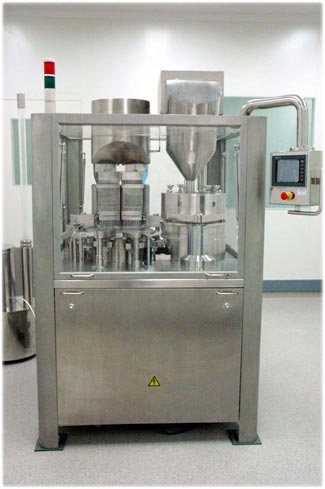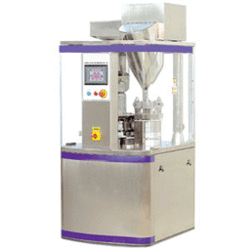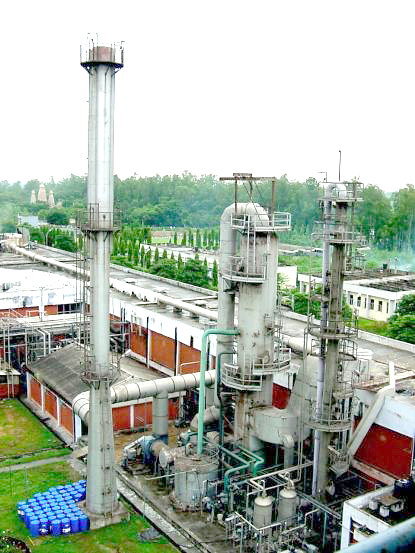|
 SPECIALTY CHEMICALS
SPECIALTY CHEMICALS
We manufacture and export specialty chemicals and drug
intermediates, specialty chemical intermediate, drug
intermediate, intermediate and speciality chemicals, chemical
drug intermediate with are formulated with the exact chemical
composition keeping in mind their application and the
requirements of the customer.
The Chemicals
business sector focuses on
high-quality chemical products for technically
demanding applications in R&D and industry. Many years of
experience and innovative product solutions make us a
preferred partner for laboratories and production.
Let us take you on a journey into our world of research to
discover new approaches that could prove useful in your work.
In regular intervals we'll be introducing you to interesting
topics, this week "On the way to a bright future"
|
Chemicals |
Case No |
 |
Phenyl
acetic acid, its esters, and its salts |
[ CAS
NO.103-82-2 ] |
 |
3,4-methylenedioxyphenyl-2-propanone |
[ CAS
NO.4676-39-5 ] |
 |
Pseudoephedrine,
its salts, optical isomers, and salts of optical isomers |
[ CAS
NO.90-82-4 ] |
 |
Piperidine
and its salts |
[ CAS
NO.110-89-4 ] |
 |
Methylamine |
[ CAS NO.
74-89-5 ] |
 |
Propionic
anhydride |
[ CAS
NO.123-62-6 ] |
 |
Para
Methoxy Phenyl Acetone |
[ CAS
NO.122-84-9 ] |
 |
Para
Methoxy Phenyl Acetic Acid |
[ CAS
NO.104-01-8 ] |
 |
Raspberry
Ketone |
[ CAS
NO.5471-51-2 ] |
 |
Benzyl
Acetone |
[ CAS
NO.2550-26-7 ] |
 |
Tyramine |
[ CAS
NO.51-67-2 ] |
 |
Biphenyl
(Phenyl benzene) |
[
CASNO.92-52-4 ] |
 |
1-phenyl-1-hexanone |
[
CASNO.942-92-7 ] |
 |
Benzene
|
[
CASNO.71-43-2 ] |
 |
Benzyl
methyl ketone |
[ CAS
NO.103-79-7] |
 |
Bromo
phenyl acetone (1-Bromo-1-phenyl-2-propanone) |
[ CAS
NO.23022-83-5 ] |
 |
3'-Aminoacetophenone |
[ CAS
NO.99-03-6 ] |
 |
3'-Chloroacetophenone |
[ CAS NO.
99-02-5 ] |
 |
Toluene
|
[ CAS NO.
108-88-3 ] |
* **The following chemicals or the salt,
optical isomer, or salt of an optical isomer of the following
chemicals
o Ethylamine
o Propionic anhydride
o Isosafrole
o Safrole
o Piperonal
o N-methylephedrine
o N-methylpseudoephedrine
o Acetic anhydride
o Acetone
o Benzyl chloride
o Diethyl ether
o Potassium permanganate
o 2-butanone (or methyl ethyl ketone)
o Toluene
o Hydrochloric acid (including anhydrous hydrogen chloride)
o Methyl isobutyl ketone
o Petroleum Products
 Petrochemical plants (plants using petroleum as a raw
material) are usually located adjacent to an oil refinery to
minimize transportation costs for the feedstocks produced by
the refinery. Specialty chemical plants are usually much
smaller and not as sensitive to location.
Petrochemical plants (plants using petroleum as a raw
material) are usually located adjacent to an oil refinery to
minimize transportation costs for the feedstocks produced by
the refinery. Specialty chemical plants are usually much
smaller and not as sensitive to location.
Chemical processes
Chemical plants typically use chemical processes, which
are detailed industrial-scale methods, to produce the
chemicals. The same chemical process can be used at more than
one chemical plant, with possibly differently scaled
capacities at each plant. Also, a chemical plant at a site may
be constructed to utilize more than one chemical process.
A chemical plant commonly has usually large vessels or
sections called units that are interconnected by piping or
other material-moving equipment which can carry streams of
material. Such material streams can include fluids (gas or
liquid carried in piping) or sometimes solids or mixtures such
as slurries. An overall chemical process is commonly made up
of steps called unit operations which occur in the individual
units. A raw material going into a chemical process or plant
as input to be converted into a product is commonly called a
feedstock, or simply feed. In addition to feedstocks for the
plant as a whole, an input stream of material to be processed
in a particular unit can similarly be considered feed for that
unit. Output streams from the plant as a whole are final
products and output streams from individual units may be
considered intermediate pro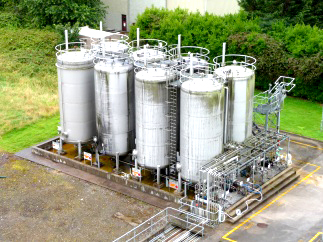 ducts
for their units. However, final products from one plant may be
intermediate chemicals used as feedstock in another plant for
further processing. For example, some products from an oil
refinery may used as feedstock in petrochemical plants. ducts
for their units. However, final products from one plant may be
intermediate chemicals used as feedstock in another plant for
further processing. For example, some products from an oil
refinery may used as feedstock in petrochemical plants.
Either the feedstock(s), the product(s), or both may be
individual compounds or mixtures. It is often not worthwhile
separating the components in these mixtures completely based
on product requirements and economics. Continuous and batch
operation
Chemical processes may be run in continuous or batch
operation. In batch operation, production occurs in
time-sequential steps in batches. A batch of feedstock(s) is
fed into a process or unit, then the chemical process takes
place, then the product(s) and any other outputs are removed.
Such batch production may be repeated over again and again
with new batches of feedstock. Batch operation is commonly
used in smaller scale plants such as pharmaceutical or
specialty chemicals production.
In continuous operation, all steps are ongoing continuously in
time. During usual continuous operation, the feeding and
product removal are ongoing streams of moving material, which
together with the process itself, all take place
simultaneously and continuously. Chemical plants or units in
continuous operation are usually in a steady state or
approximate steady state. Steady state means that quantities
related to the process do not change as time passes during
operation. Such constant quantities include stream flow rates,
heating or cooling rates, temperatures, pressures, and
chemical compositions at every point (location). Continuous
operation is more efficient in many large scale operations
like petroleum refineries. It is possible for some units to
operate continuously and others be in batch operation in a
chemical plant; for example, see Continuous distillation and
Batch distillation. The amount of primary feedstock or product
per unit of time which a plant or unit can process is referred
to as the capacity of that plant or unit. For examples: the
capacity of an oil refinery may be given in terms of barrels
of crude oil refined per day; alternatively chemical plant
capacity may be given in tons of product produced per day. In
actual daily operation, a plant (or unit) will operate at a
percentage of its full capacity.
 Plant
operation >> Plant
operation >>
Process control
In process control, information gathered automatically from
various sensors or other
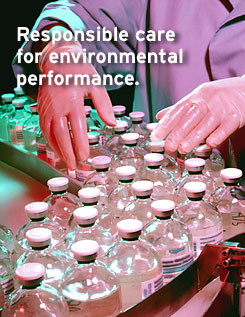 devices in the plant is used to
control various equipment for running the plant, thereby
controlling operation of the plant. Instruments receiving such
information signals and sending out control signals to perform
this function automatically are process controllers.
Previously, pneumatic controls were sometimes used. Electrical
controls are now common. A plant often has a control room with
displays of parameters such as key temperatures, pressures,
fluid flow rates and levels, operating positions of key
valves, pumps and other equipment, etc. In addition, operators
in the control room can control various aspects of the plant
operation, often including overriding automatic control.
Process control with a computer represents more modern
technology. Based on possible changing feedstock composition,
changing products requirements or economics, or other changes
in constraints, operating conditions may be re-optimized to
maximize profit. devices in the plant is used to
control various equipment for running the plant, thereby
controlling operation of the plant. Instruments receiving such
information signals and sending out control signals to perform
this function automatically are process controllers.
Previously, pneumatic controls were sometimes used. Electrical
controls are now common. A plant often has a control room with
displays of parameters such as key temperatures, pressures,
fluid flow rates and levels, operating positions of key
valves, pumps and other equipment, etc. In addition, operators
in the control room can control various aspects of the plant
operation, often including overriding automatic control.
Process control with a computer represents more modern
technology. Based on possible changing feedstock composition,
changing products requirements or economics, or other changes
in constraints, operating conditions may be re-optimized to
maximize profit.
Workers
As in any industrial setting, there are a variety of workers
working throughout a chemical plant facility, often organized
into departments, sections, or other work groups. Such workers
typically include engineers, plant operators, and maintenance
technicians. Other personnel at the site could include
chemists, management/administration and office workers. Types
of engineers involved in operations or maintenance may include
chemical process engineers, mechanical engineers for
maintaining mechanical equipment, and electrical/computer
engineers for electrical or computer equipment.
Transport
Large quantities of fluid feedstock or product may enter or
leave a plant by pipeline, railroad tank car, or tanker truck.
For example, petroleum commonly comes to a refinery by
pipeline. Pipelines can also carry petrochemical feedstock
from a refinery to a nearby petrochemical plant. Natural gas
is a product which comes all the way from a natural gas
processing plant to final consumers by pipeline or tubing.
Large quantities of liquid feedstock are typically pumped into
process units. Smaller quantities of feedstock or product may
be shipped to or from a plant in drums. Use of drums about 55
gallons in capacity is common for packaging industrial
quantities of chemicals. Smaller batches of feedstock may be
added from drums or other containers to process units by
workers.
 Manufacturing
Plants / Units Manufacturing
Plants / Units
 Virtual Tour of
Plants Virtual Tour of
Plants
|




 ducts
for their units. However, final products from one plant may be
intermediate chemicals used as feedstock in another plant for
further processing. For example, some products from an oil
refinery may used as feedstock in petrochemical plants.
ducts
for their units. However, final products from one plant may be
intermediate chemicals used as feedstock in another plant for
further processing. For example, some products from an oil
refinery may used as feedstock in petrochemical plants. devices in the plant is used to
control various equipment for running the plant, thereby
controlling operation of the plant. Instruments receiving such
information signals and sending out control signals to perform
this function automatically are process controllers.
Previously, pneumatic controls were sometimes used. Electrical
controls are now common. A plant often has a control room with
displays of parameters such as key temperatures, pressures,
fluid flow rates and levels, operating positions of key
valves, pumps and other equipment, etc. In addition, operators
in the control room can control various aspects of the plant
operation, often including overriding automatic control.
Process control with a computer represents more modern
technology. Based on possible changing feedstock composition,
changing products requirements or economics, or other changes
in constraints, operating conditions may be re-optimized to
maximize profit.
devices in the plant is used to
control various equipment for running the plant, thereby
controlling operation of the plant. Instruments receiving such
information signals and sending out control signals to perform
this function automatically are process controllers.
Previously, pneumatic controls were sometimes used. Electrical
controls are now common. A plant often has a control room with
displays of parameters such as key temperatures, pressures,
fluid flow rates and levels, operating positions of key
valves, pumps and other equipment, etc. In addition, operators
in the control room can control various aspects of the plant
operation, often including overriding automatic control.
Process control with a computer represents more modern
technology. Based on possible changing feedstock composition,
changing products requirements or economics, or other changes
in constraints, operating conditions may be re-optimized to
maximize profit.